Report on Information Systems and Big Data Analysis for Business
VerifiedAdded on 2023/06/10
|10
|3240
|134
Report
AI Summary
This report explores the role of information systems and big data analysis in business, focusing on IT solutions like Moodle and MS Office, and their application within organizations like TESCO. It discusses various systems such as DSS, ESS, TPS, MIS, and KSM, highlighting their functions and benefits in decision-making and information management. The report also examines the impact of globalization on IT, the definition and implications of digital infrastructure, and the risks associated with information systems outsourcing. Furthermore, it emphasizes the critical role of IT infrastructure in driving digital transformation, offering a comprehensive overview of how these elements interrelate to support business operations and strategic development.
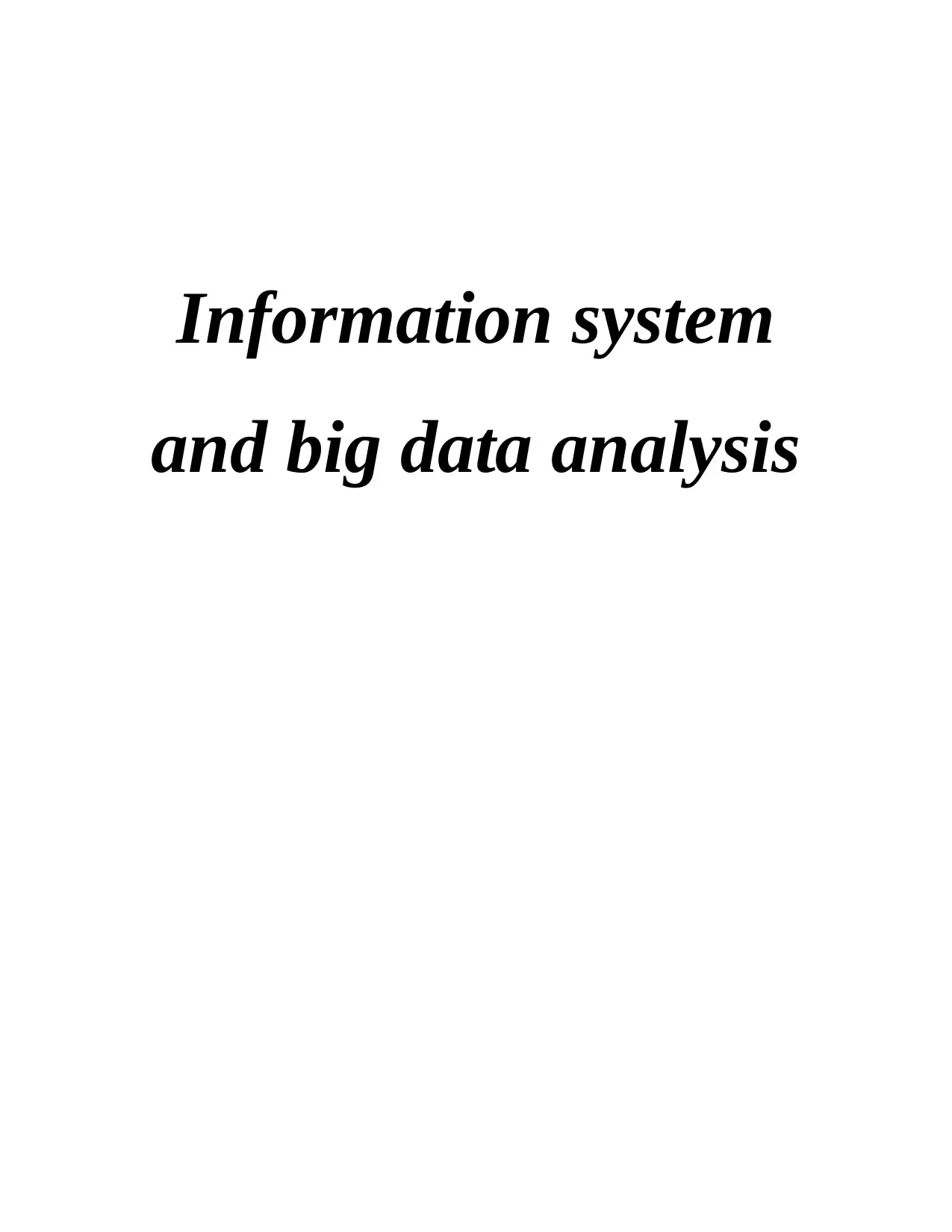
Information system
and big data analysis
and big data analysis
Paraphrase This Document
Need a fresh take? Get an instant paraphrase of this document with our AI Paraphraser
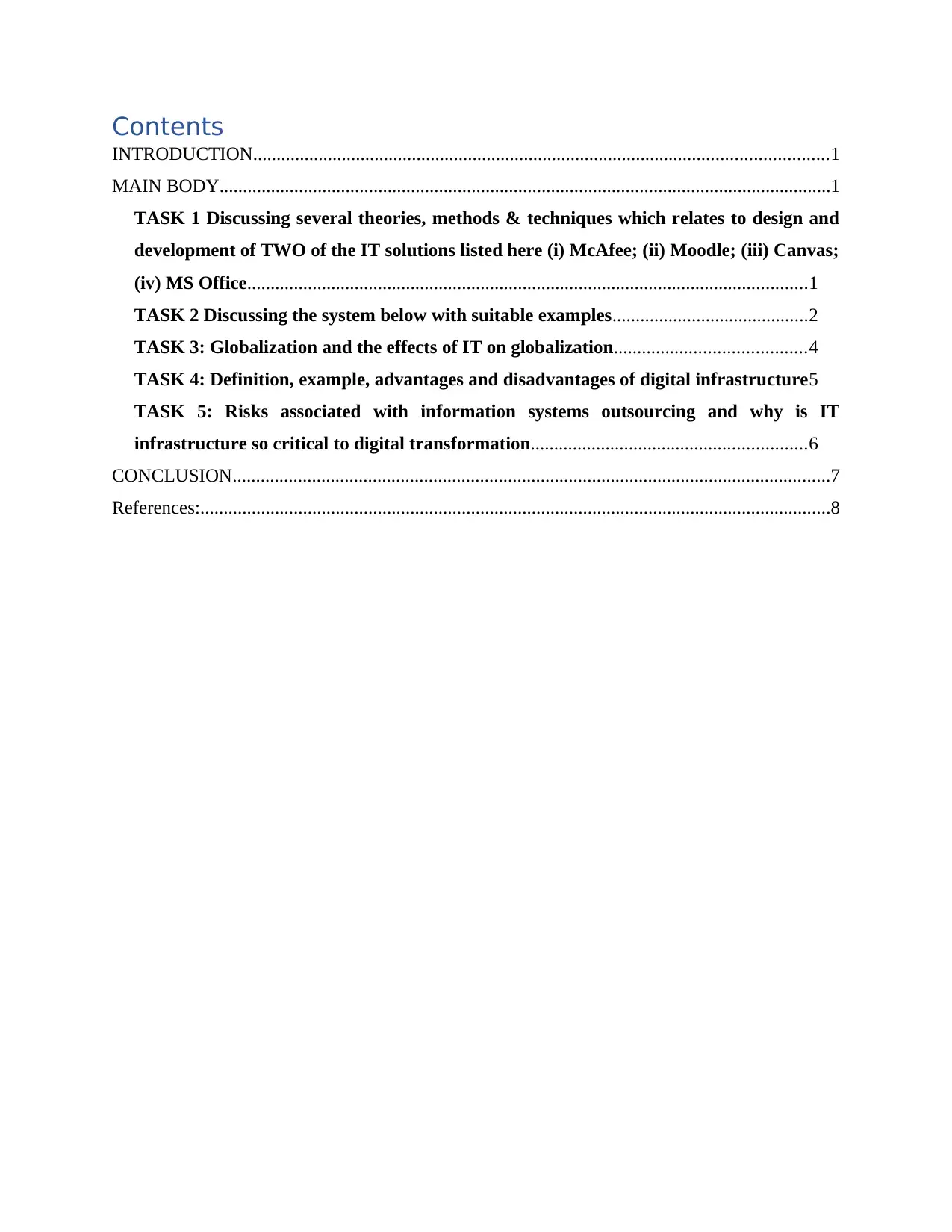
Contents
INTRODUCTION...........................................................................................................................1
MAIN BODY...................................................................................................................................1
TASK 1 Discussing several theories, methods & techniques which relates to design and
development of TWO of the IT solutions listed here (i) McAfee; (ii) Moodle; (iii) Canvas;
(iv) MS Office........................................................................................................................1
TASK 2 Discussing the system below with suitable examples..........................................2
TASK 3: Globalization and the effects of IT on globalization.........................................4
TASK 4: Definition, example, advantages and disadvantages of digital infrastructure5
TASK 5: Risks associated with information systems outsourcing and why is IT
infrastructure so critical to digital transformation...........................................................6
CONCLUSION................................................................................................................................7
References:.......................................................................................................................................8
INTRODUCTION...........................................................................................................................1
MAIN BODY...................................................................................................................................1
TASK 1 Discussing several theories, methods & techniques which relates to design and
development of TWO of the IT solutions listed here (i) McAfee; (ii) Moodle; (iii) Canvas;
(iv) MS Office........................................................................................................................1
TASK 2 Discussing the system below with suitable examples..........................................2
TASK 3: Globalization and the effects of IT on globalization.........................................4
TASK 4: Definition, example, advantages and disadvantages of digital infrastructure5
TASK 5: Risks associated with information systems outsourcing and why is IT
infrastructure so critical to digital transformation...........................................................6
CONCLUSION................................................................................................................................7
References:.......................................................................................................................................8
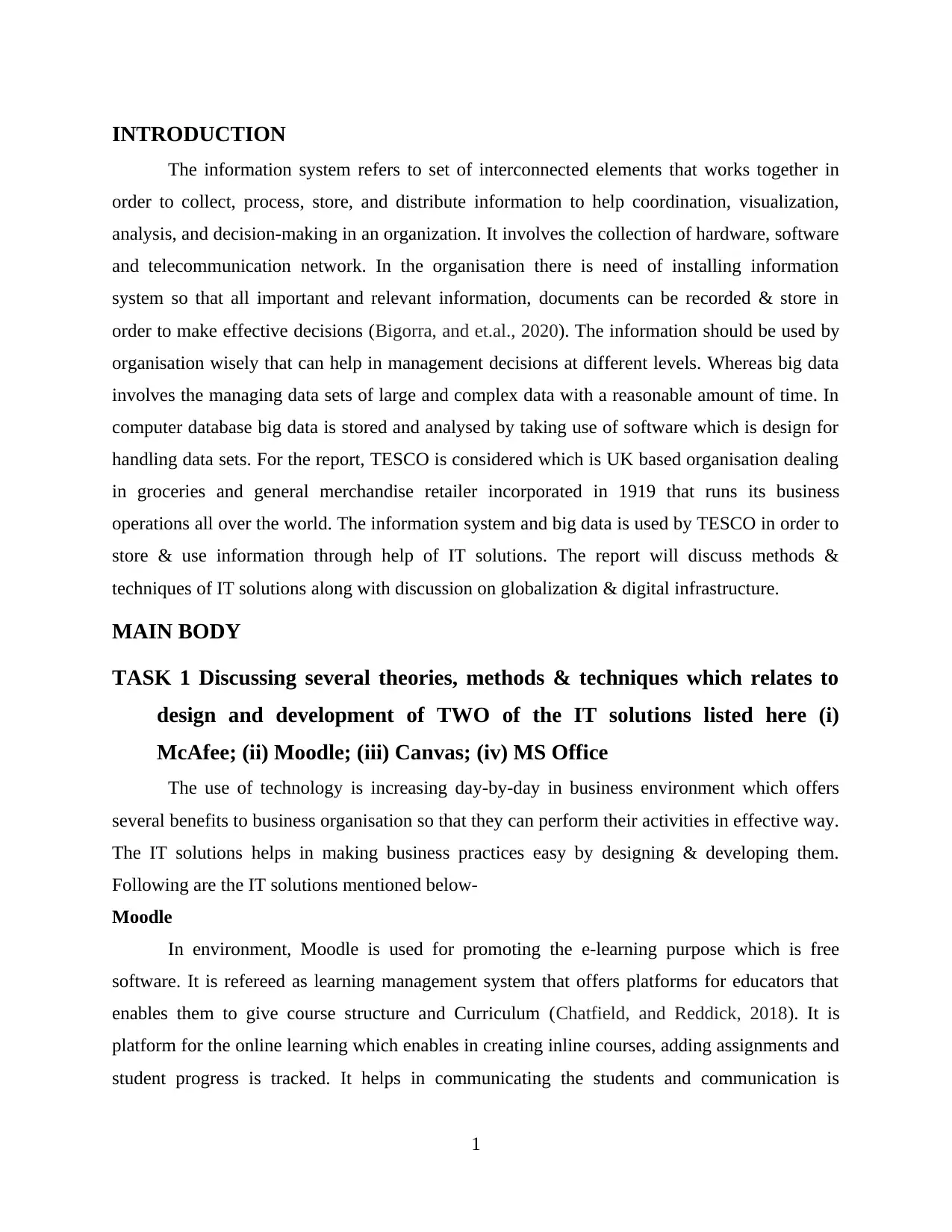
INTRODUCTION
The information system refers to set of interconnected elements that works together in
order to collect, process, store, and distribute information to help coordination, visualization,
analysis, and decision-making in an organization. It involves the collection of hardware, software
and telecommunication network. In the organisation there is need of installing information
system so that all important and relevant information, documents can be recorded & store in
order to make effective decisions (Bigorra, and et.al., 2020). The information should be used by
organisation wisely that can help in management decisions at different levels. Whereas big data
involves the managing data sets of large and complex data with a reasonable amount of time. In
computer database big data is stored and analysed by taking use of software which is design for
handling data sets. For the report, TESCO is considered which is UK based organisation dealing
in groceries and general merchandise retailer incorporated in 1919 that runs its business
operations all over the world. The information system and big data is used by TESCO in order to
store & use information through help of IT solutions. The report will discuss methods &
techniques of IT solutions along with discussion on globalization & digital infrastructure.
MAIN BODY
TASK 1 Discussing several theories, methods & techniques which relates to
design and development of TWO of the IT solutions listed here (i)
McAfee; (ii) Moodle; (iii) Canvas; (iv) MS Office
The use of technology is increasing day-by-day in business environment which offers
several benefits to business organisation so that they can perform their activities in effective way.
The IT solutions helps in making business practices easy by designing & developing them.
Following are the IT solutions mentioned below-
Moodle
In environment, Moodle is used for promoting the e-learning purpose which is free
software. It is refereed as learning management system that offers platforms for educators that
enables them to give course structure and Curriculum (Chatfield, and Reddick, 2018). It is
platform for the online learning which enables in creating inline courses, adding assignments and
student progress is tracked. It helps in communicating the students and communication is
1
The information system refers to set of interconnected elements that works together in
order to collect, process, store, and distribute information to help coordination, visualization,
analysis, and decision-making in an organization. It involves the collection of hardware, software
and telecommunication network. In the organisation there is need of installing information
system so that all important and relevant information, documents can be recorded & store in
order to make effective decisions (Bigorra, and et.al., 2020). The information should be used by
organisation wisely that can help in management decisions at different levels. Whereas big data
involves the managing data sets of large and complex data with a reasonable amount of time. In
computer database big data is stored and analysed by taking use of software which is design for
handling data sets. For the report, TESCO is considered which is UK based organisation dealing
in groceries and general merchandise retailer incorporated in 1919 that runs its business
operations all over the world. The information system and big data is used by TESCO in order to
store & use information through help of IT solutions. The report will discuss methods &
techniques of IT solutions along with discussion on globalization & digital infrastructure.
MAIN BODY
TASK 1 Discussing several theories, methods & techniques which relates to
design and development of TWO of the IT solutions listed here (i)
McAfee; (ii) Moodle; (iii) Canvas; (iv) MS Office
The use of technology is increasing day-by-day in business environment which offers
several benefits to business organisation so that they can perform their activities in effective way.
The IT solutions helps in making business practices easy by designing & developing them.
Following are the IT solutions mentioned below-
Moodle
In environment, Moodle is used for promoting the e-learning purpose which is free
software. It is refereed as learning management system that offers platforms for educators that
enables them to give course structure and Curriculum (Chatfield, and Reddick, 2018). It is
platform for the online learning which enables in creating inline courses, adding assignments and
student progress is tracked. It helps in communicating the students and communication is
1
⊘ This is a preview!⊘
Do you want full access?
Subscribe today to unlock all pages.

Trusted by 1+ million students worldwide

encouraged. The students have interaction with tutors by online with the help of Moodle. Martin
Dougiams developed the Moodle which was having agenda of e-learning and online education. It
is acronym as Modular object- oriented dynamic learning environment. The design of Moodle is
for both organisation and institutions. The important use of Moodle involves on-boarding,
compliance and competency-based training, hiring & interview process, online course
development, establishing of new product & services etc. This IT solution is becoming popular
after Pandemic where restriction was on physical contacts.
MS-office
It is family of client software, server software and services developed by Microsoft. The
wide range of services are offered in accordance to organisation needs. In the workplace and
home, it is becoming an leading platform which drives productivity. MS-office is designed for
every field and sector in environment (Chiang, and Chang, 2019). Every organisation in the
workplace uses MS office which is becoming universal software. The use of Ms office can be in
several fields such as financial management, cost savings, collaborative work, competition and
system security. In context to TESCO in workplace several benefits are provided to organisation
as there is upgrading of technology from time to time. The MS offices involves MS words, MS
power point and MS excel etc.
TASK 2 Discussing the system below with suitable examples
DSS (Decision support system)
This defines to computerised program which is used for supporting the determinations,
judgements and course of actions in organisation. It helps TESCO in analysing big amount of
data, compiling comprehensive information which can be used for solving problems & in
decision making. This system is primarily used by mid-to upper-level management. It is
automated and human powered (Dahlbom, and et.al., 2020). In order to produce detail
information DSS helps in gathering and analysing data. From the normal application it is
different as normal applications only collects data whereas this software helps in analysing them.
The GPS route planning is example for decision support system.
ESS (Executive Support System)
This system allow user to modify enterprise data into quick approachable and executive
level reports which is used by billing, accounting and staffing departments. The decision making
2
Dougiams developed the Moodle which was having agenda of e-learning and online education. It
is acronym as Modular object- oriented dynamic learning environment. The design of Moodle is
for both organisation and institutions. The important use of Moodle involves on-boarding,
compliance and competency-based training, hiring & interview process, online course
development, establishing of new product & services etc. This IT solution is becoming popular
after Pandemic where restriction was on physical contacts.
MS-office
It is family of client software, server software and services developed by Microsoft. The
wide range of services are offered in accordance to organisation needs. In the workplace and
home, it is becoming an leading platform which drives productivity. MS-office is designed for
every field and sector in environment (Chiang, and Chang, 2019). Every organisation in the
workplace uses MS office which is becoming universal software. The use of Ms office can be in
several fields such as financial management, cost savings, collaborative work, competition and
system security. In context to TESCO in workplace several benefits are provided to organisation
as there is upgrading of technology from time to time. The MS offices involves MS words, MS
power point and MS excel etc.
TASK 2 Discussing the system below with suitable examples
DSS (Decision support system)
This defines to computerised program which is used for supporting the determinations,
judgements and course of actions in organisation. It helps TESCO in analysing big amount of
data, compiling comprehensive information which can be used for solving problems & in
decision making. This system is primarily used by mid-to upper-level management. It is
automated and human powered (Dahlbom, and et.al., 2020). In order to produce detail
information DSS helps in gathering and analysing data. From the normal application it is
different as normal applications only collects data whereas this software helps in analysing them.
The GPS route planning is example for decision support system.
ESS (Executive Support System)
This system allow user to modify enterprise data into quick approachable and executive
level reports which is used by billing, accounting and staffing departments. The decision making
2
Paraphrase This Document
Need a fresh take? Get an instant paraphrase of this document with our AI Paraphraser
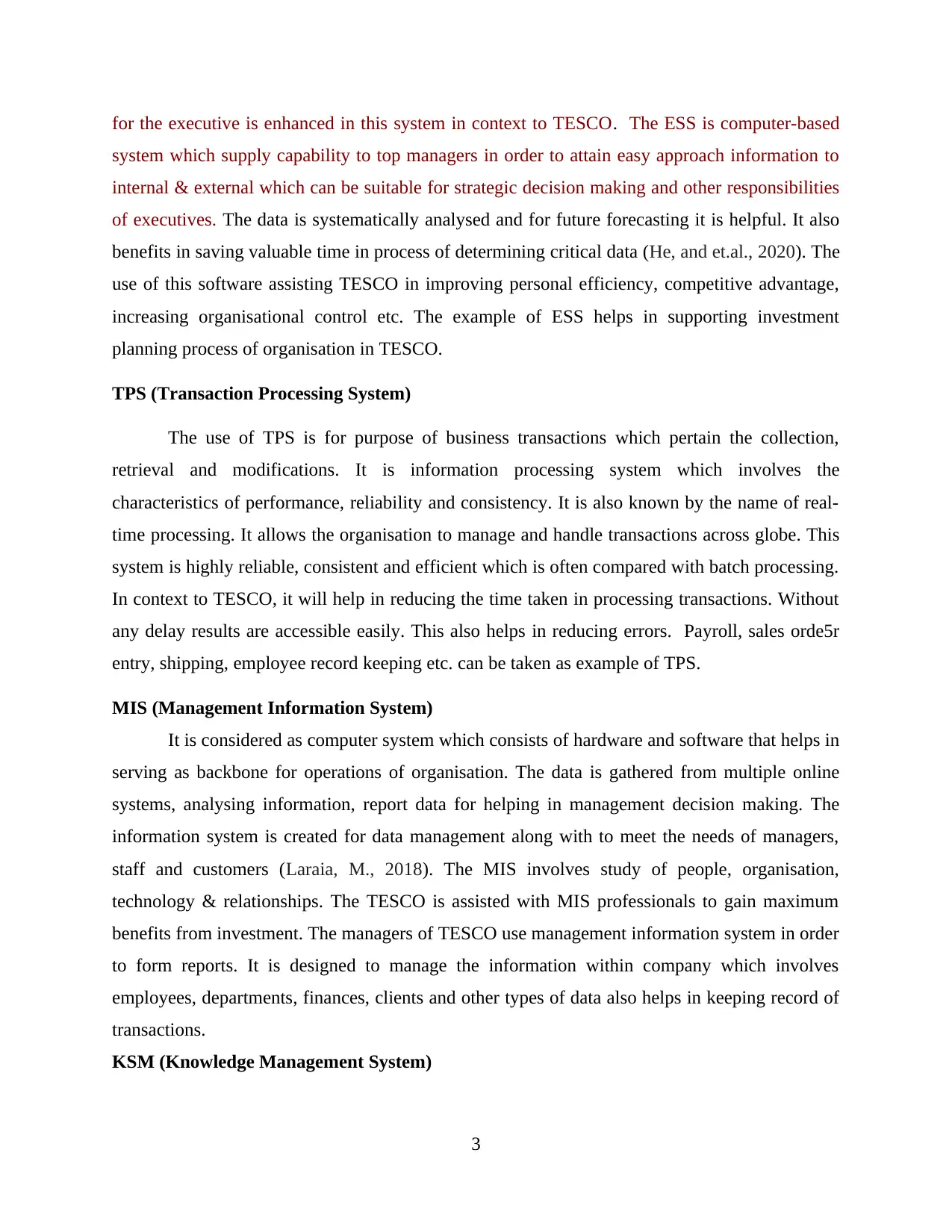
for the executive is enhanced in this system in context to TESCO. The ESS is computer-based
system which supply capability to top managers in order to attain easy approach information to
internal & external which can be suitable for strategic decision making and other responsibilities
of executives. The data is systematically analysed and for future forecasting it is helpful. It also
benefits in saving valuable time in process of determining critical data (He, and et.al., 2020). The
use of this software assisting TESCO in improving personal efficiency, competitive advantage,
increasing organisational control etc. The example of ESS helps in supporting investment
planning process of organisation in TESCO.
TPS (Transaction Processing System)
The use of TPS is for purpose of business transactions which pertain the collection,
retrieval and modifications. It is information processing system which involves the
characteristics of performance, reliability and consistency. It is also known by the name of real-
time processing. It allows the organisation to manage and handle transactions across globe. This
system is highly reliable, consistent and efficient which is often compared with batch processing.
In context to TESCO, it will help in reducing the time taken in processing transactions. Without
any delay results are accessible easily. This also helps in reducing errors. Payroll, sales orde5r
entry, shipping, employee record keeping etc. can be taken as example of TPS.
MIS (Management Information System)
It is considered as computer system which consists of hardware and software that helps in
serving as backbone for operations of organisation. The data is gathered from multiple online
systems, analysing information, report data for helping in management decision making. The
information system is created for data management along with to meet the needs of managers,
staff and customers (Laraia, M., 2018). The MIS involves study of people, organisation,
technology & relationships. The TESCO is assisted with MIS professionals to gain maximum
benefits from investment. The managers of TESCO use management information system in order
to form reports. It is designed to manage the information within company which involves
employees, departments, finances, clients and other types of data also helps in keeping record of
transactions.
KSM (Knowledge Management System)
3
system which supply capability to top managers in order to attain easy approach information to
internal & external which can be suitable for strategic decision making and other responsibilities
of executives. The data is systematically analysed and for future forecasting it is helpful. It also
benefits in saving valuable time in process of determining critical data (He, and et.al., 2020). The
use of this software assisting TESCO in improving personal efficiency, competitive advantage,
increasing organisational control etc. The example of ESS helps in supporting investment
planning process of organisation in TESCO.
TPS (Transaction Processing System)
The use of TPS is for purpose of business transactions which pertain the collection,
retrieval and modifications. It is information processing system which involves the
characteristics of performance, reliability and consistency. It is also known by the name of real-
time processing. It allows the organisation to manage and handle transactions across globe. This
system is highly reliable, consistent and efficient which is often compared with batch processing.
In context to TESCO, it will help in reducing the time taken in processing transactions. Without
any delay results are accessible easily. This also helps in reducing errors. Payroll, sales orde5r
entry, shipping, employee record keeping etc. can be taken as example of TPS.
MIS (Management Information System)
It is considered as computer system which consists of hardware and software that helps in
serving as backbone for operations of organisation. The data is gathered from multiple online
systems, analysing information, report data for helping in management decision making. The
information system is created for data management along with to meet the needs of managers,
staff and customers (Laraia, M., 2018). The MIS involves study of people, organisation,
technology & relationships. The TESCO is assisted with MIS professionals to gain maximum
benefits from investment. The managers of TESCO use management information system in order
to form reports. It is designed to manage the information within company which involves
employees, departments, finances, clients and other types of data also helps in keeping record of
transactions.
KSM (Knowledge Management System)
3
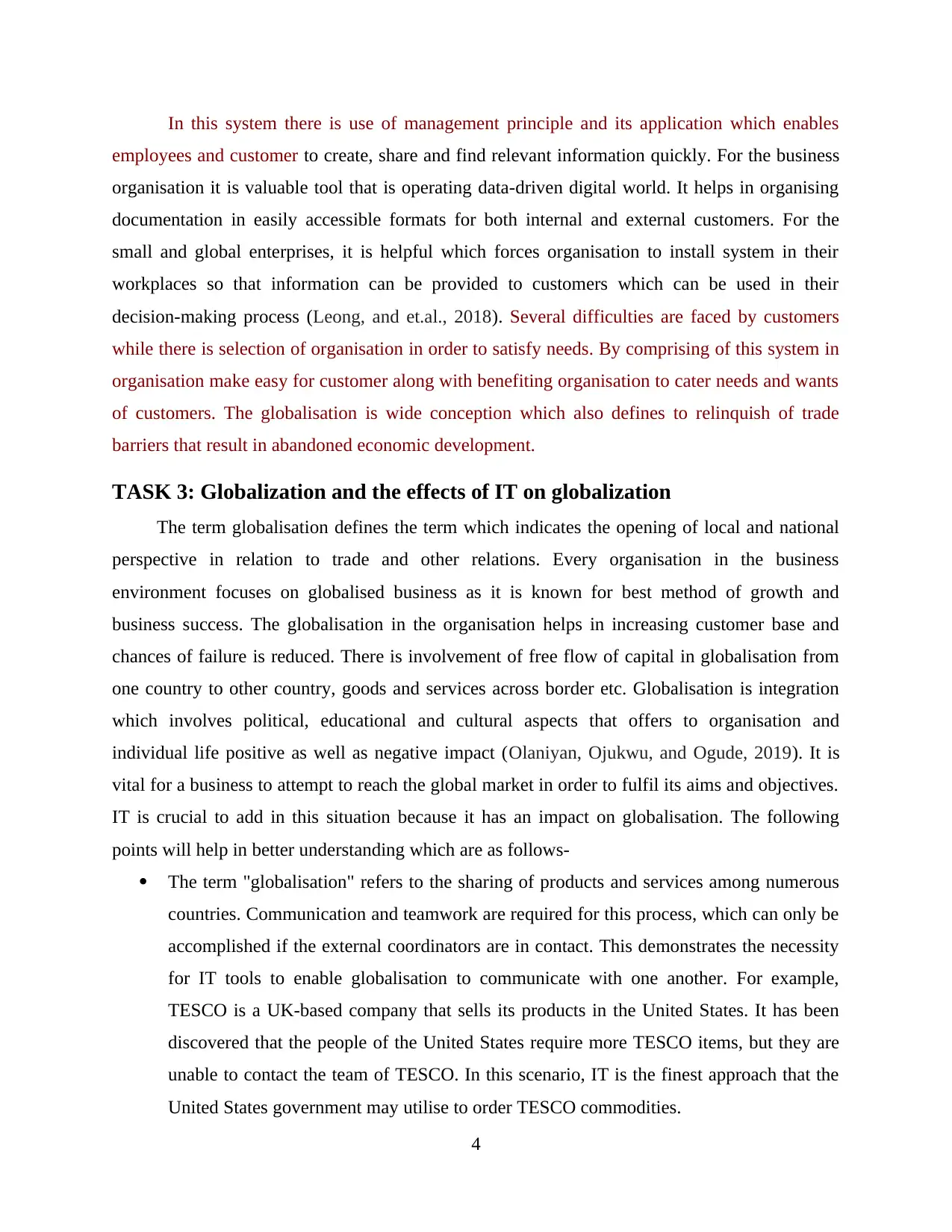
In this system there is use of management principle and its application which enables
employees and customer to create, share and find relevant information quickly. For the business
organisation it is valuable tool that is operating data-driven digital world. It helps in organising
documentation in easily accessible formats for both internal and external customers. For the
small and global enterprises, it is helpful which forces organisation to install system in their
workplaces so that information can be provided to customers which can be used in their
decision-making process (Leong, and et.al., 2018). Several difficulties are faced by customers
while there is selection of organisation in order to satisfy needs. By comprising of this system in
organisation make easy for customer along with benefiting organisation to cater needs and wants
of customers. The globalisation is wide conception which also defines to relinquish of trade
barriers that result in abandoned economic development.
TASK 3: Globalization and the effects of IT on globalization
The term globalisation defines the term which indicates the opening of local and national
perspective in relation to trade and other relations. Every organisation in the business
environment focuses on globalised business as it is known for best method of growth and
business success. The globalisation in the organisation helps in increasing customer base and
chances of failure is reduced. There is involvement of free flow of capital in globalisation from
one country to other country, goods and services across border etc. Globalisation is integration
which involves political, educational and cultural aspects that offers to organisation and
individual life positive as well as negative impact (Olaniyan, Ojukwu, and Ogude, 2019). It is
vital for a business to attempt to reach the global market in order to fulfil its aims and objectives.
IT is crucial to add in this situation because it has an impact on globalisation. The following
points will help in better understanding which are as follows-
The term "globalisation" refers to the sharing of products and services among numerous
countries. Communication and teamwork are required for this process, which can only be
accomplished if the external coordinators are in contact. This demonstrates the necessity
for IT tools to enable globalisation to communicate with one another. For example,
TESCO is a UK-based company that sells its products in the United States. It has been
discovered that the people of the United States require more TESCO items, but they are
unable to contact the team of TESCO. In this scenario, IT is the finest approach that the
United States government may utilise to order TESCO commodities.
4
employees and customer to create, share and find relevant information quickly. For the business
organisation it is valuable tool that is operating data-driven digital world. It helps in organising
documentation in easily accessible formats for both internal and external customers. For the
small and global enterprises, it is helpful which forces organisation to install system in their
workplaces so that information can be provided to customers which can be used in their
decision-making process (Leong, and et.al., 2018). Several difficulties are faced by customers
while there is selection of organisation in order to satisfy needs. By comprising of this system in
organisation make easy for customer along with benefiting organisation to cater needs and wants
of customers. The globalisation is wide conception which also defines to relinquish of trade
barriers that result in abandoned economic development.
TASK 3: Globalization and the effects of IT on globalization
The term globalisation defines the term which indicates the opening of local and national
perspective in relation to trade and other relations. Every organisation in the business
environment focuses on globalised business as it is known for best method of growth and
business success. The globalisation in the organisation helps in increasing customer base and
chances of failure is reduced. There is involvement of free flow of capital in globalisation from
one country to other country, goods and services across border etc. Globalisation is integration
which involves political, educational and cultural aspects that offers to organisation and
individual life positive as well as negative impact (Olaniyan, Ojukwu, and Ogude, 2019). It is
vital for a business to attempt to reach the global market in order to fulfil its aims and objectives.
IT is crucial to add in this situation because it has an impact on globalisation. The following
points will help in better understanding which are as follows-
The term "globalisation" refers to the sharing of products and services among numerous
countries. Communication and teamwork are required for this process, which can only be
accomplished if the external coordinators are in contact. This demonstrates the necessity
for IT tools to enable globalisation to communicate with one another. For example,
TESCO is a UK-based company that sells its products in the United States. It has been
discovered that the people of the United States require more TESCO items, but they are
unable to contact the team of TESCO. In this scenario, IT is the finest approach that the
United States government may utilise to order TESCO commodities.
4
⊘ This is a preview!⊘
Do you want full access?
Subscribe today to unlock all pages.

Trusted by 1+ million students worldwide

On globalisation information technology has both a direct and indirect impact.
Individuals used to converse with people from other countries through telephones and
telegraphs in the past. However, it takes too long, and some people are unable to obtain
the information.
Information Technology has been discovered to provide numerous benefits and solutions
to organisations in their efforts to globalize. It lowers communication and transportation
costs. For example, social media is a crucial tool for engaging with people from different
countries (Palgrave Macmillan, and et. al., 2020).
Information technology is a major driver of globalisation. For example, it has been
discovered that using the internet to conduct business decreases the barriers of distance
and time. It also has an impact on investments.
TASK 4: Definition, example, advantages and disadvantages of digital
infrastructure
The foundation of an organization's information and technology is digital infrastructure,
which is described as digital technology. It is critical for businesses to develop a digital
infrastructure since it has become both a necessity and a trend in the industry. In today's digital
environment, firms must incorporate all digital tools in order to be successful. The following are
some of the benefits and drawbacks of digital infrastructure which are as follows-
Benefits
The opportunity of income and increase trade is generated which also helps in connecting
people and places.
The organisation productivity & sustainability is improved which is important for
recognising brand (Sivaparthipan, and et.al., 2020).
The organisation is invited for adopting new technologies in digital infrastructure that
helps in taking competitive advantage.
Drawbacks
Cyberattacks are becoming more common as a result of digital infrastructure. Enterprises
are concerned about their confidential information being leaked as a result of increased
usage of digital technology.
5
Individuals used to converse with people from other countries through telephones and
telegraphs in the past. However, it takes too long, and some people are unable to obtain
the information.
Information Technology has been discovered to provide numerous benefits and solutions
to organisations in their efforts to globalize. It lowers communication and transportation
costs. For example, social media is a crucial tool for engaging with people from different
countries (Palgrave Macmillan, and et. al., 2020).
Information technology is a major driver of globalisation. For example, it has been
discovered that using the internet to conduct business decreases the barriers of distance
and time. It also has an impact on investments.
TASK 4: Definition, example, advantages and disadvantages of digital
infrastructure
The foundation of an organization's information and technology is digital infrastructure,
which is described as digital technology. It is critical for businesses to develop a digital
infrastructure since it has become both a necessity and a trend in the industry. In today's digital
environment, firms must incorporate all digital tools in order to be successful. The following are
some of the benefits and drawbacks of digital infrastructure which are as follows-
Benefits
The opportunity of income and increase trade is generated which also helps in connecting
people and places.
The organisation productivity & sustainability is improved which is important for
recognising brand (Sivaparthipan, and et.al., 2020).
The organisation is invited for adopting new technologies in digital infrastructure that
helps in taking competitive advantage.
Drawbacks
Cyberattacks are becoming more common as a result of digital infrastructure. Enterprises
are concerned about their confidential information being leaked as a result of increased
usage of digital technology.
5
Paraphrase This Document
Need a fresh take? Get an instant paraphrase of this document with our AI Paraphraser
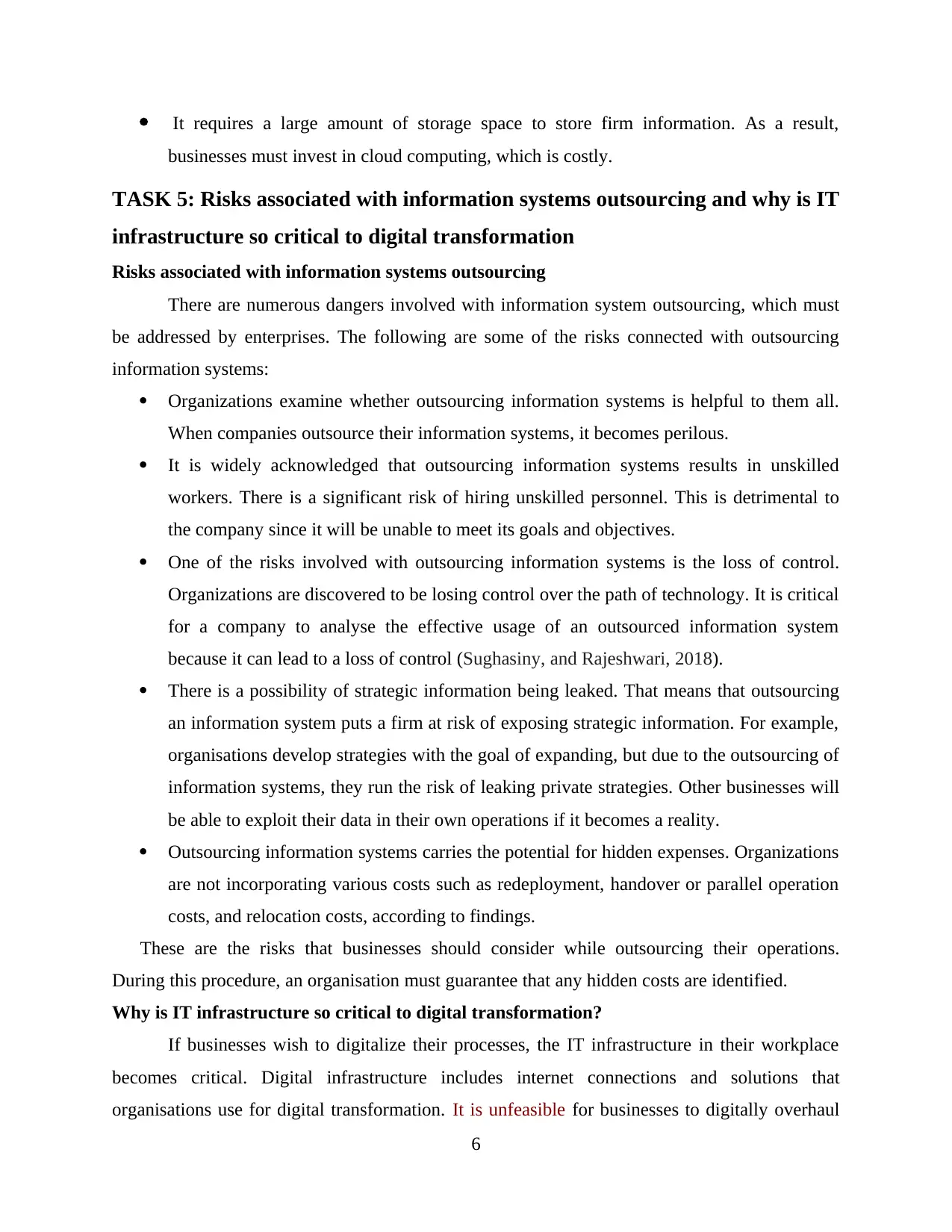
It requires a large amount of storage space to store firm information. As a result,
businesses must invest in cloud computing, which is costly.
TASK 5: Risks associated with information systems outsourcing and why is IT
infrastructure so critical to digital transformation
Risks associated with information systems outsourcing
There are numerous dangers involved with information system outsourcing, which must
be addressed by enterprises. The following are some of the risks connected with outsourcing
information systems:
Organizations examine whether outsourcing information systems is helpful to them all.
When companies outsource their information systems, it becomes perilous.
It is widely acknowledged that outsourcing information systems results in unskilled
workers. There is a significant risk of hiring unskilled personnel. This is detrimental to
the company since it will be unable to meet its goals and objectives.
One of the risks involved with outsourcing information systems is the loss of control.
Organizations are discovered to be losing control over the path of technology. It is critical
for a company to analyse the effective usage of an outsourced information system
because it can lead to a loss of control (Sughasiny, and Rajeshwari, 2018).
There is a possibility of strategic information being leaked. That means that outsourcing
an information system puts a firm at risk of exposing strategic information. For example,
organisations develop strategies with the goal of expanding, but due to the outsourcing of
information systems, they run the risk of leaking private strategies. Other businesses will
be able to exploit their data in their own operations if it becomes a reality.
Outsourcing information systems carries the potential for hidden expenses. Organizations
are not incorporating various costs such as redeployment, handover or parallel operation
costs, and relocation costs, according to findings.
These are the risks that businesses should consider while outsourcing their operations.
During this procedure, an organisation must guarantee that any hidden costs are identified.
Why is IT infrastructure so critical to digital transformation?
If businesses wish to digitalize their processes, the IT infrastructure in their workplace
becomes critical. Digital infrastructure includes internet connections and solutions that
organisations use for digital transformation. It is unfeasible for businesses to digitally overhaul
6
businesses must invest in cloud computing, which is costly.
TASK 5: Risks associated with information systems outsourcing and why is IT
infrastructure so critical to digital transformation
Risks associated with information systems outsourcing
There are numerous dangers involved with information system outsourcing, which must
be addressed by enterprises. The following are some of the risks connected with outsourcing
information systems:
Organizations examine whether outsourcing information systems is helpful to them all.
When companies outsource their information systems, it becomes perilous.
It is widely acknowledged that outsourcing information systems results in unskilled
workers. There is a significant risk of hiring unskilled personnel. This is detrimental to
the company since it will be unable to meet its goals and objectives.
One of the risks involved with outsourcing information systems is the loss of control.
Organizations are discovered to be losing control over the path of technology. It is critical
for a company to analyse the effective usage of an outsourced information system
because it can lead to a loss of control (Sughasiny, and Rajeshwari, 2018).
There is a possibility of strategic information being leaked. That means that outsourcing
an information system puts a firm at risk of exposing strategic information. For example,
organisations develop strategies with the goal of expanding, but due to the outsourcing of
information systems, they run the risk of leaking private strategies. Other businesses will
be able to exploit their data in their own operations if it becomes a reality.
Outsourcing information systems carries the potential for hidden expenses. Organizations
are not incorporating various costs such as redeployment, handover or parallel operation
costs, and relocation costs, according to findings.
These are the risks that businesses should consider while outsourcing their operations.
During this procedure, an organisation must guarantee that any hidden costs are identified.
Why is IT infrastructure so critical to digital transformation?
If businesses wish to digitalize their processes, the IT infrastructure in their workplace
becomes critical. Digital infrastructure includes internet connections and solutions that
organisations use for digital transformation. It is unfeasible for businesses to digitally overhaul
6
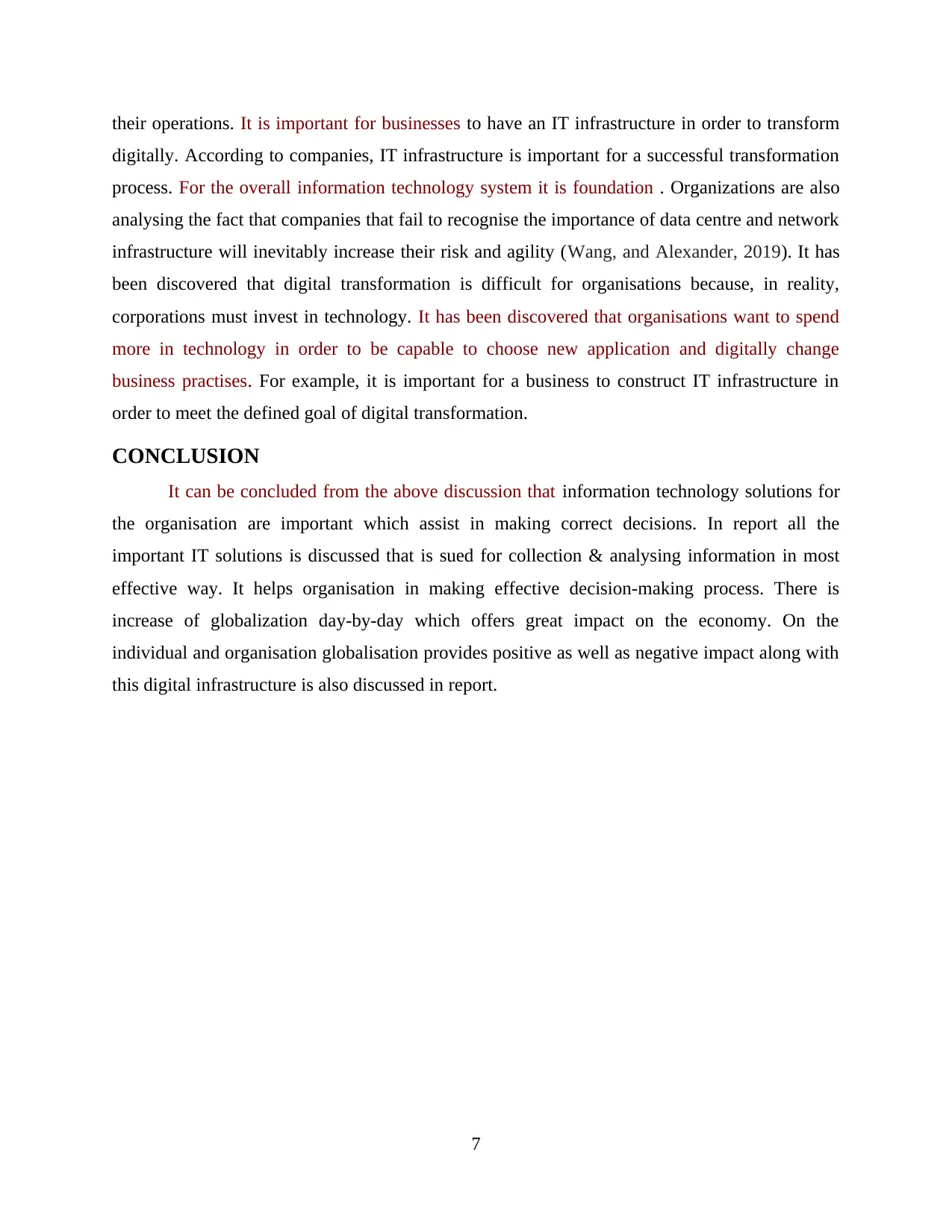
their operations. It is important for businesses to have an IT infrastructure in order to transform
digitally. According to companies, IT infrastructure is important for a successful transformation
process. For the overall information technology system it is foundation . Organizations are also
analysing the fact that companies that fail to recognise the importance of data centre and network
infrastructure will inevitably increase their risk and agility (Wang, and Alexander, 2019). It has
been discovered that digital transformation is difficult for organisations because, in reality,
corporations must invest in technology. It has been discovered that organisations want to spend
more in technology in order to be capable to choose new application and digitally change
business practises. For example, it is important for a business to construct IT infrastructure in
order to meet the defined goal of digital transformation.
CONCLUSION
It can be concluded from the above discussion that information technology solutions for
the organisation are important which assist in making correct decisions. In report all the
important IT solutions is discussed that is sued for collection & analysing information in most
effective way. It helps organisation in making effective decision-making process. There is
increase of globalization day-by-day which offers great impact on the economy. On the
individual and organisation globalisation provides positive as well as negative impact along with
this digital infrastructure is also discussed in report.
7
digitally. According to companies, IT infrastructure is important for a successful transformation
process. For the overall information technology system it is foundation . Organizations are also
analysing the fact that companies that fail to recognise the importance of data centre and network
infrastructure will inevitably increase their risk and agility (Wang, and Alexander, 2019). It has
been discovered that digital transformation is difficult for organisations because, in reality,
corporations must invest in technology. It has been discovered that organisations want to spend
more in technology in order to be capable to choose new application and digitally change
business practises. For example, it is important for a business to construct IT infrastructure in
order to meet the defined goal of digital transformation.
CONCLUSION
It can be concluded from the above discussion that information technology solutions for
the organisation are important which assist in making correct decisions. In report all the
important IT solutions is discussed that is sued for collection & analysing information in most
effective way. It helps organisation in making effective decision-making process. There is
increase of globalization day-by-day which offers great impact on the economy. On the
individual and organisation globalisation provides positive as well as negative impact along with
this digital infrastructure is also discussed in report.
7
⊘ This is a preview!⊘
Do you want full access?
Subscribe today to unlock all pages.

Trusted by 1+ million students worldwide
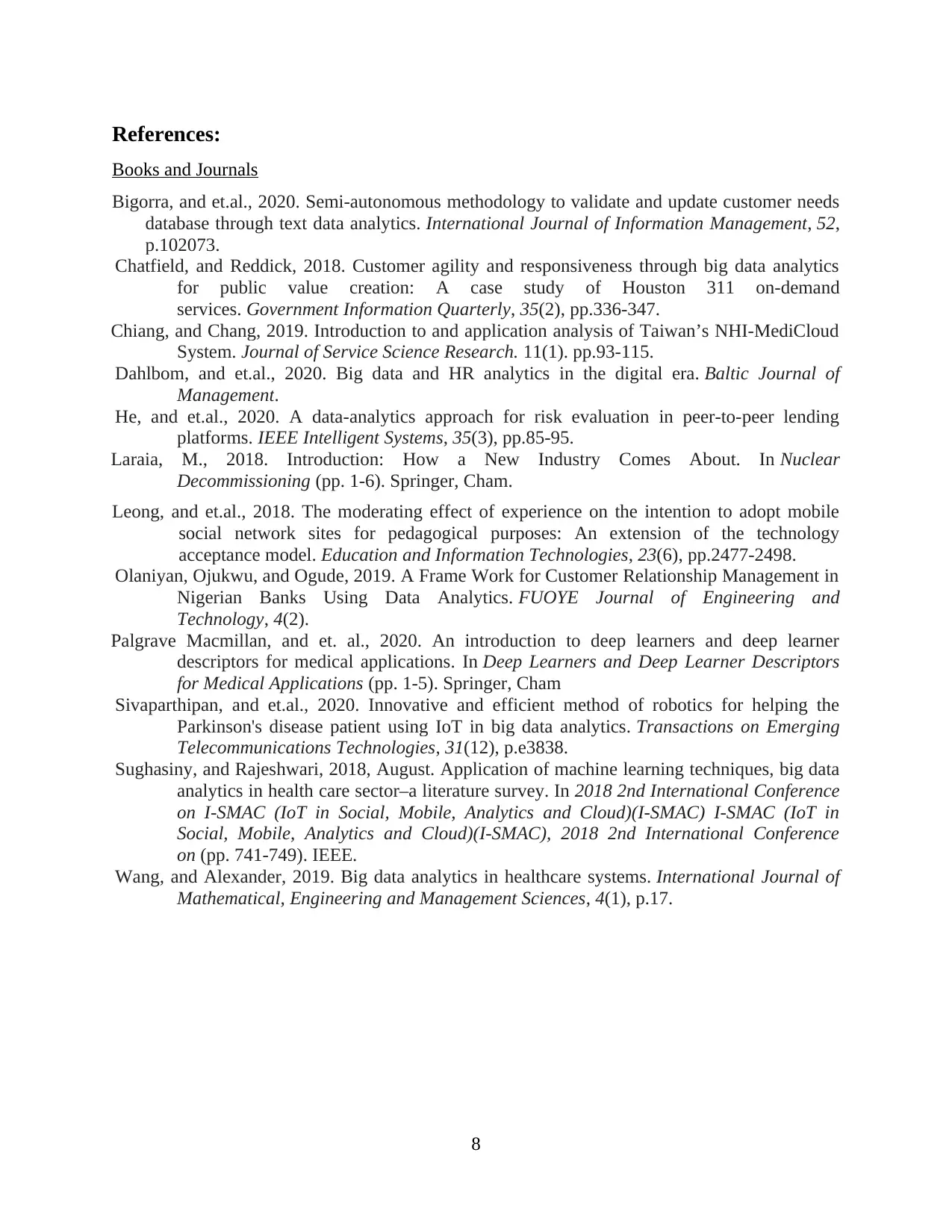
References:
Books and Journals
Bigorra, and et.al., 2020. Semi-autonomous methodology to validate and update customer needs
database through text data analytics. International Journal of Information Management, 52,
p.102073.
Chatfield, and Reddick, 2018. Customer agility and responsiveness through big data analytics
for public value creation: A case study of Houston 311 on-demand
services. Government Information Quarterly, 35(2), pp.336-347.
Chiang, and Chang, 2019. Introduction to and application analysis of Taiwan’s NHI-MediCloud
System. Journal of Service Science Research. 11(1). pp.93-115.
Dahlbom, and et.al., 2020. Big data and HR analytics in the digital era. Baltic Journal of
Management.
He, and et.al., 2020. A data-analytics approach for risk evaluation in peer-to-peer lending
platforms. IEEE Intelligent Systems, 35(3), pp.85-95.
Laraia, M., 2018. Introduction: How a New Industry Comes About. In Nuclear
Decommissioning (pp. 1-6). Springer, Cham.
Leong, and et.al., 2018. The moderating effect of experience on the intention to adopt mobile
social network sites for pedagogical purposes: An extension of the technology
acceptance model. Education and Information Technologies, 23(6), pp.2477-2498.
Olaniyan, Ojukwu, and Ogude, 2019. A Frame Work for Customer Relationship Management in
Nigerian Banks Using Data Analytics. FUOYE Journal of Engineering and
Technology, 4(2).
Palgrave Macmillan, and et. al., 2020. An introduction to deep learners and deep learner
descriptors for medical applications. In Deep Learners and Deep Learner Descriptors
for Medical Applications (pp. 1-5). Springer, Cham
Sivaparthipan, and et.al., 2020. Innovative and efficient method of robotics for helping the
Parkinson's disease patient using IoT in big data analytics. Transactions on Emerging
Telecommunications Technologies, 31(12), p.e3838.
Sughasiny, and Rajeshwari, 2018, August. Application of machine learning techniques, big data
analytics in health care sector–a literature survey. In 2018 2nd International Conference
on I-SMAC (IoT in Social, Mobile, Analytics and Cloud)(I-SMAC) I-SMAC (IoT in
Social, Mobile, Analytics and Cloud)(I-SMAC), 2018 2nd International Conference
on (pp. 741-749). IEEE.
Wang, and Alexander, 2019. Big data analytics in healthcare systems. International Journal of
Mathematical, Engineering and Management Sciences, 4(1), p.17.
8
Books and Journals
Bigorra, and et.al., 2020. Semi-autonomous methodology to validate and update customer needs
database through text data analytics. International Journal of Information Management, 52,
p.102073.
Chatfield, and Reddick, 2018. Customer agility and responsiveness through big data analytics
for public value creation: A case study of Houston 311 on-demand
services. Government Information Quarterly, 35(2), pp.336-347.
Chiang, and Chang, 2019. Introduction to and application analysis of Taiwan’s NHI-MediCloud
System. Journal of Service Science Research. 11(1). pp.93-115.
Dahlbom, and et.al., 2020. Big data and HR analytics in the digital era. Baltic Journal of
Management.
He, and et.al., 2020. A data-analytics approach for risk evaluation in peer-to-peer lending
platforms. IEEE Intelligent Systems, 35(3), pp.85-95.
Laraia, M., 2018. Introduction: How a New Industry Comes About. In Nuclear
Decommissioning (pp. 1-6). Springer, Cham.
Leong, and et.al., 2018. The moderating effect of experience on the intention to adopt mobile
social network sites for pedagogical purposes: An extension of the technology
acceptance model. Education and Information Technologies, 23(6), pp.2477-2498.
Olaniyan, Ojukwu, and Ogude, 2019. A Frame Work for Customer Relationship Management in
Nigerian Banks Using Data Analytics. FUOYE Journal of Engineering and
Technology, 4(2).
Palgrave Macmillan, and et. al., 2020. An introduction to deep learners and deep learner
descriptors for medical applications. In Deep Learners and Deep Learner Descriptors
for Medical Applications (pp. 1-5). Springer, Cham
Sivaparthipan, and et.al., 2020. Innovative and efficient method of robotics for helping the
Parkinson's disease patient using IoT in big data analytics. Transactions on Emerging
Telecommunications Technologies, 31(12), p.e3838.
Sughasiny, and Rajeshwari, 2018, August. Application of machine learning techniques, big data
analytics in health care sector–a literature survey. In 2018 2nd International Conference
on I-SMAC (IoT in Social, Mobile, Analytics and Cloud)(I-SMAC) I-SMAC (IoT in
Social, Mobile, Analytics and Cloud)(I-SMAC), 2018 2nd International Conference
on (pp. 741-749). IEEE.
Wang, and Alexander, 2019. Big data analytics in healthcare systems. International Journal of
Mathematical, Engineering and Management Sciences, 4(1), p.17.
8
1 out of 10
Related Documents
Your All-in-One AI-Powered Toolkit for Academic Success.
+13062052269
info@desklib.com
Available 24*7 on WhatsApp / Email
![[object Object]](/_next/static/media/star-bottom.7253800d.svg)
Unlock your academic potential
Copyright © 2020–2025 A2Z Services. All Rights Reserved. Developed and managed by ZUCOL.




